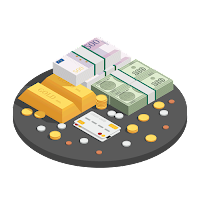The Support / Resistance indicator for MetaTrader is designed to simply draw the support and resistance lines that the price makes. Since the levels calculation is done automatically, the indicator settings are almost non-existent, with the trader having the option to change the SR lines colors.

Trading Based on Support and Resistance Lines
Support and resistance lines are two of the most important concepts in technical analysis. They can help traders identify the potential direction and strength of a price trend, as well as the optimal entry and exit points for trades.
What are support and resistance lines?
Support and resistance lines are horizontal or slightly slanted lines that indicate the levels where the price tends to bounce back or reverse. They are formed by the interaction of supply and demand in the market.
Support lines are the levels where the price finds support from buyers, who prevent it from falling further. Resistance lines are the levels where the price faces resistance from sellers, who prevent it from rising further.
Support and resistance lines can be drawn by connecting the lowest and highest points of a price movement, respectively. They can also be identified by using technical indicators, such as moving averages, trendlines, or Fibonacci retracements.
Why are support and resistance lines important?
Support and resistance lines are important because they can provide traders with valuable information about the market sentiment and the balance of power between buyers and sellers. They can also help traders anticipate the possible future price movements and plan their trading strategies accordingly.
Benefits of using support and resistance lines
– They can help traders identify the direction and strength of a price trend. A price trend is considered to be strong if it breaks through multiple support or resistance lines, or weak if it fails to do so.
– They can help traders determine the optimal entry and exit points for trades. Traders can use support and resistance lines to spot the potential reversal or continuation signals in the market. For example, a trader can buy (go long) when the price bounces off a support line, or sell (go short) when the price bounces off a resistance line. Alternatively, a trader can buy when the price breaks above a resistance line, or sell when the price breaks below a support line, indicating a trend change.
– They can help traders manage their risk and reward ratios. Traders can use support and resistance lines to set their stop-loss and take-profit orders, which can protect them from unexpected price movements and lock in their profits. For example, a trader can place a stop-loss order below a support line, or above a resistance line, depending on the direction of their trade. Similarly, a trader can place a take-profit order near a resistance line, or near a support line, depending on the direction of their trade.
How to trade based on support and resistance lines?
Trading based on support and resistance lines can be a simple and effective way to profit from the price fluctuations in the market. However, traders should be aware of the limitations and challenges of using support and resistance lines, such as:
Support and resistance lines are not fixed or exact. They are more like zones or ranges, where the price can fluctuate slightly above or below the lines. Therefore, traders should not rely solely on support and resistance lines, but use other technical tools and indicators to confirm their signals.
Support and resistance lines can change over time. They can become stronger or weaker, depending on the number of times the price tests them. They can also become invalid or obsolete, if the price breaks through them significantly or stays away from them for a long time. Therefore, traders should constantly monitor and update their support and resistance lines, and adjust their trading strategies accordingly.
Support and resistance lines can be influenced by external factors. They can be affected by the news, events, or emotions that can cause sudden spikes or drops in the price. Therefore, traders should be aware of the market conditions and the potential risks that can impact their support and resistance lines.
To trade based on support and resistance lines, traders should follow these steps:
Identify the support and resistance lines on the price chart, using historical data, previous levels, or technical indicators.
Determine the direction and strength of the price trend, by observing how the price interacts with the support and resistance lines.
Choose a trading strategy, based on the expected price movement and the risk-reward ratio. For example, a trader can use a bounce strategy, a breakout strategy, or a combination of both.
Execute the trade, by entering the market at the desired price level, and setting the stop-loss and take-profit orders accordingly.
Monitor the trade, by watching the price action and the support and resistance lines, and closing the trade when the target is reached or the signal is invalidated.
Support and resistance lines are powerful tools that can help traders analyze and trade the price movements in the market. They can provide traders with useful information about the market sentiment, the trend direction and strength, and the optimal entry and exit points for trades. However, traders should also be aware of the limitations and challenges of using support and resistance lines, and use other technical tools and indicators to confirm their signals. Trading based on support and resistance lines can be a simple and effective way to profit from the market, if done correctly and cautiously.









Tony Rollins (verified owner) –
It is easy to use and understand, and it works well with other indicators and strategies.